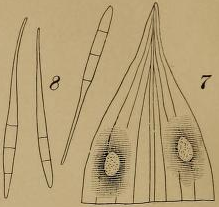Pseudocercosporella capsellae
P. capsellae has a significant effect on crop yields on agricultural products, such as canola seed and rapeseed.
The ascocarp of M. capsellae is a cleistothecium, meaning asci are shielded from the environment prior to ascospore release.
[5] These chains of conidia are attached to a long conidiophore and stipe, connecting these asexual structures to the sterile hyphal network of the fungal body.
In culture, P. capsellae appears black and white on potato dextrose agar (PDA).
When observed under a microscope, P. capsellae appears a reddish-purple color due to the fungus' production of a purple-pink pigment.
[3] At these temperate conditions and in ample humidity, conidia can be spread to new host plants via wind, water droplet splash, or by improperly sanitized farm equipment.
In rare cases, cover crops or neighboring species of weeds can act as secondary hosts for the sexual stage of P.
[3] Sanitation of farm equipment and crop rotation are methods of reducing initial inoculum of conidia produced by P. capsellae.
Breeding genetic resistance towards P. capsellae is a promising method for disease management of this pathogen.


